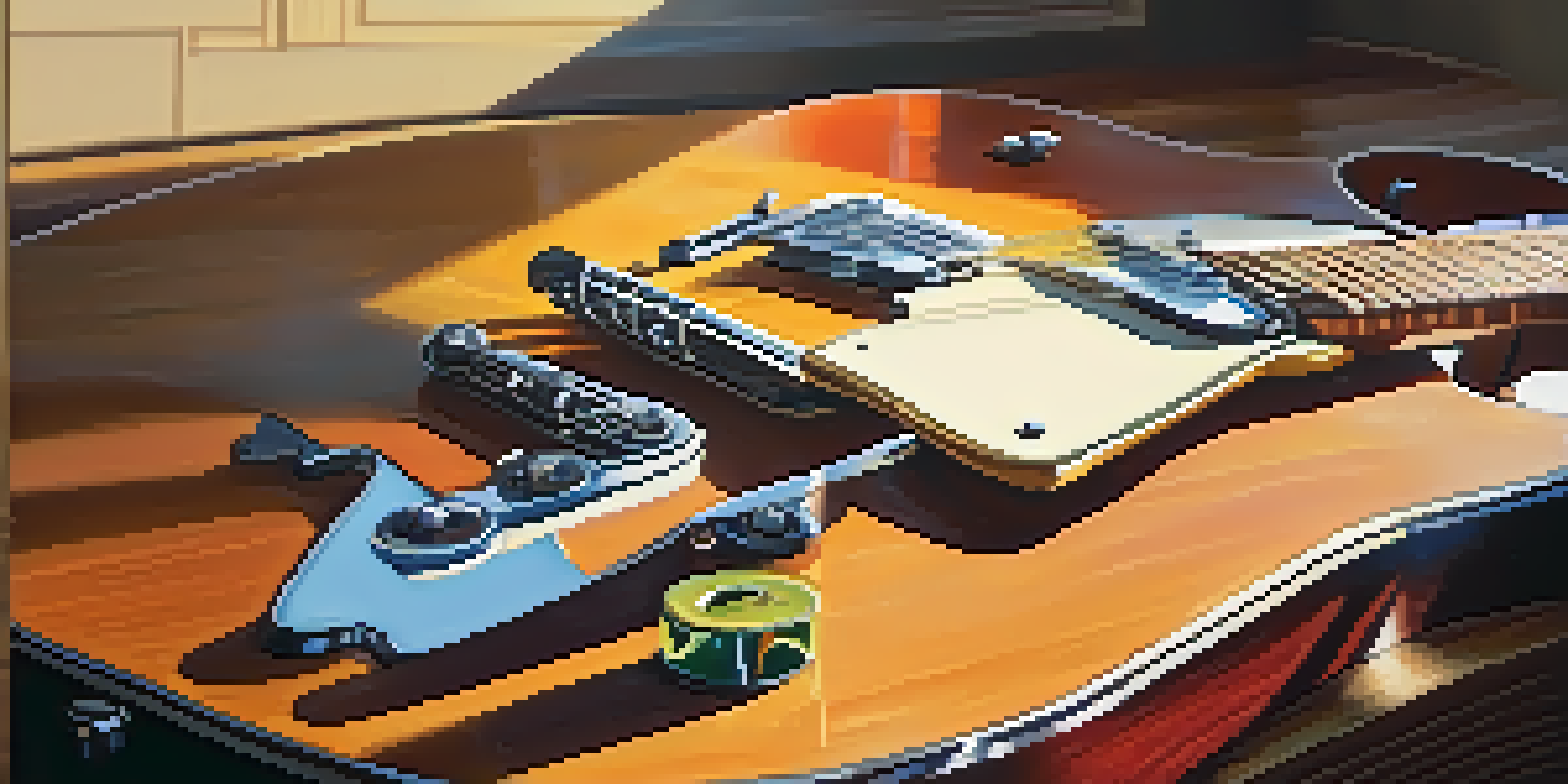Mixing Guitar Tracks: Techniques for a Polished Sound

Understanding the Importance of Mixing Guitar Tracks
Mixing guitar tracks is a crucial step in music production that can make or break a song. It’s not just about balancing volume levels; it’s about creating a cohesive sound that enhances the overall listening experience. When done right, mixing allows each guitar track to shine while complementing other instruments in the mix.
Mixing is not just about getting the levels right; it's about creating an experience for the listener.
Imagine mixing your favorite band’s album; the guitar parts have a distinct role, whether they’re driving the rhythm or adding melodic flourishes. A well-mixed guitar track should feel like a conversation, where each part speaks clearly without overshadowing the others. This balance is what keeps listeners engaged and wanting more.
Ultimately, understanding the importance of mixing guitar tracks sets the foundation for creating professional-sounding music. By focusing on clarity and balance, you’ll be on your way to crafting tracks that not only sound good but also resonate with your audience.
Choosing the Right Guitar Sounds and Textures
Before diving into mixing, it’s essential to start with great guitar sounds and textures. The choice of guitar, amp, and effects can greatly influence how the track will sit in the mix. For instance, a clean-toned electric guitar can provide a bright, shimmering quality, while a distorted tone can add grit and intensity.

Think of your guitar parts like colors on a painter's palette—each sound adds a unique hue to your mix. Experimenting with different combinations can lead to interesting textures that enhance the overall feel of the track. Don't shy away from layering multiple guitar sounds to create a richer tapestry.
Mixing Enhances Listening Experience
Effective mixing allows each guitar track to shine and creates a cohesive sound that engages listeners.
Ultimately, the right sounds can make the mixing process smoother and more enjoyable. By carefully selecting and crafting your guitar tones, you set yourself up for a more polished final product that will captivate listeners.
Utilizing Panning to Create Space in Your Mix
Panning is a powerful tool in mixing that allows you to position your guitar tracks within the stereo field. By distributing sounds between the left and right channels, you can create a sense of space and depth. For example, panning rhythm guitars slightly to one side while placing lead guitars in the center can create a more engaging audio experience.
The magic of music is in the details, and mixing is where those details come to life.
Imagine a live band performing on stage; you’d want to hear the guitars in their respective positions, right? By mimicking this spatial arrangement in your mix, you create a more dynamic and immersive listening experience. It’s all about guiding your audience’s ears to where you want them to focus.
However, be mindful not to overdo it—too much panning can lead to a disorienting mix. Striking the right balance allows for clarity, ensuring that each guitar part can be heard clearly without conflicting with others.
Applying EQ to Enhance Guitar Frequencies
Equalization, or EQ, is one of your best friends when mixing guitar tracks. It allows you to boost or cut specific frequency ranges to ensure each guitar part sits well in the mix. For instance, cutting some low frequencies from a rhythm guitar can create more space for the bass guitar, resulting in a cleaner sound.
Think of EQ as a sculpting tool; it's all about shaping the sound to fit together harmoniously. By adjusting the EQ settings, you can enhance the tonal qualities of each guitar, making them more distinct and less muddy. This clarity is crucial for a polished final mix.
Panning Creates Spatial Depth
Utilizing panning positions guitar tracks within the stereo field, enhancing the overall audio experience.
Remember to use your ears as your guide. Trust your instincts when making EQ adjustments, and don’t be afraid to experiment. The goal is to create a balanced sound that allows each guitar track to contribute to the overall mix without overpowering one another.
Using Compression to Control Dynamics in Guitar Tracks
Compression is essential for managing the dynamic range of guitar tracks. By applying compression, you can even out the volume levels, making quieter parts more audible and preventing louder sections from overwhelming the mix. This creates a more polished sound that feels cohesive.
Imagine a rollercoaster ride; the thrill comes from the ups and downs, but if it’s too chaotic, it becomes uncomfortable. Similarly, compression helps maintain excitement in your guitar tracks without letting them become too unruly. It keeps the energy flowing while ensuring clarity.
When using compression, pay attention to the attack and release settings. A faster attack can help tame sharp transients, while a slower release can add sustain to your notes. Finding the right settings will greatly enhance your guitar tracks, making them sit beautifully in the mix.
Adding Effects to Enrich Your Guitar Sound
Effects can bring your guitar tracks to life, adding depth and character that enhances the overall mix. Reverb and delay are popular effects that can create a sense of space, making the guitars feel more immersive. A touch of reverb can simulate a live performance, while delay can add rhythmic interest.
Think of effects as the seasoning in your favorite dish—they can elevate the flavor when used correctly. However, too much can overpower the original sound, so moderation is key. Start with subtle settings and gradually increase until you find the right balance.
EQ and Compression Improve Clarity
Applying EQ and compression helps shape guitar sounds, ensuring clarity and balance in the final mix.
Don’t be afraid to experiment with different effects chains. Layering effects can lead to unique sounds that set your guitar tracks apart. The goal is to complement the music without overshadowing the core guitar tones.
Finalizing Your Mix: Balancing and Mastering Guitar Tracks
After you've shaped your guitar tracks with all these techniques, it’s time to finalize your mix. This involves balancing the volume levels of each track to ensure nothing is fighting for attention. The goal is to create a blend where every part is audible and contributes to the overall sound.
Think of this stage like a chef plating a dish; it's about presentation and ensuring everything looks and sounds appetizing. Fine-tuning the balance, adjusting panning, and revisiting EQ and effects will help you achieve that polished sound. Take your time to listen critically and make adjustments as needed.

Once you’re satisfied with the mix, mastering is the final step that ensures your guitars sound great across all playback systems. This process can make your tracks sound more professional and polished, ready for distribution and audiences worldwide. With a little patience and care, you’ll be proud of the finished product.